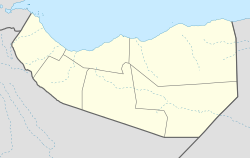
Somalia, officially the Federal Republic of Somalia, is a country in the Horn of Africa. It is bordered by Ethiopia to the west, Djibouti to the Northwest, the Gulf of Aden to the north, the Indian Ocean to the east, and Kenya to the southwest. Somalia has the longest coastline on Africa's mainland. Its terrain consists mainly of plateaus, plains, and highlands. Hot conditions prevail year-round, with periodic monsoon winds and irregular rainfall. Somalia has an estimated population of around 15 million, of which over 2 million live in the capital and largest city Mogadishu, and has been described as Africa's most culturally homogeneous country. Around 85% of its residents are ethnic Somalis, who have historically inhabited the country's north. Ethnic minorities are largely concentrated in the south. The official languages of Somalia are Somali and Arabic. Most people in the country are Muslims, the majority of them Sunni.
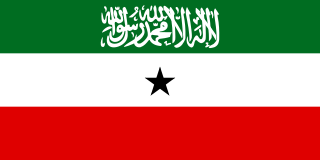
Somaliland, officially the Republic of Somaliland, is an unrecognised sovereign state in the Horn of Africa, internationally considered to be part of Somalia. Somaliland lies in the Horn of Africa, on the southern coast of the Gulf of Aden. It is bordered by Djibouti to the northwest, Ethiopia to the south and west, and Somalia to the east. Its claimed territory has an area of 176,120 square kilometres (68,000 sq mi), with approximately 3.5 million residents in 2014. The capital and largest city is Hargeisa. The government of Somaliland regards itself as the successor state to British Somaliland, which, as the briefly independent State of Somaliland, united in 1960 with the Trust Territory of Somaliland to form the Somali Republic.
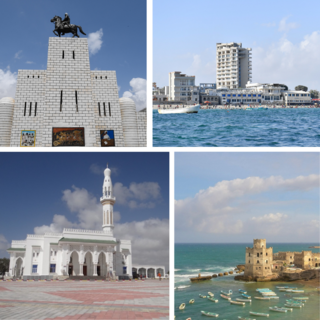
Mogadishu, locally known as Xamar or Hamar, is the capital city and most populous city of Somalia. The city has served as an important port connecting with traders all round the Indian Ocean for millennia and has an estimated population of 2,388,000 (2021). Mogadishu is located in the coastal Banadir region on the Indian Ocean, which unlike other Somali regions, is considered a municipality rather than a maamul goboleed.
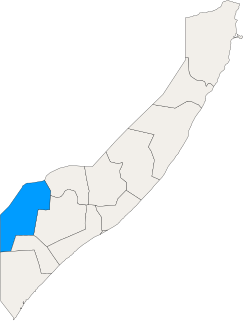
Gedo is an administrative region (gobol) in Jubaland, southern Somalia. Its regional capital is Garbahaarreey. It was created in 1974 and is bordered by the Ogaden in Ethiopia, the North Eastern Province in Kenya, and the Somali regions of Bakool, Bay, Jubbada Dhexe, and Jubbada Hoose further down east. The southern parts of Gedo, west of the Jubba River, used to be part of the old British Trans-Juba region during half of the seventy years of colonial era in Africa from 1890 to 1960. The British and Italians fought twice over this area. The first democratically elected governor of the administrative region was Hussein Farey, who entered office in 2008.

Somali is an Afroasiatic language belonging to the Cushitic branch. It is spoken as a mother tongue by Somalis in Greater Somalia and the Somali diaspora. Somali is an official language of Somalia and Somaliland, a national language in Djibouti, and a working language in the Somali Region of Ethiopia and also in North Eastern Kenya. The Somali language is written officially with the Latin alphabet although the Arabic alphabet and several Somali scripts like Osmanya and the Borama script are informally used.

The Somalis are an East Cushitic ethnic group native to the Horn of Africa who share a common ancestry, culture and history. The Somali language is the shared mother tongue of ethnic Somalis, which is part of the Cushitic branch of the Afroasiatic language family, and are predominately Sunni Muslim. They form one of the largest ethnic groups on the African continent, and cover one of the most expansive landmasses by a single ethnic group in Africa.
This article is about the culture of natives of the Indian state of Goa. Goans are commonly said to be born with music and football in their blood. This is because football and music are deeply entrenched in Goan culture.

Chinchinim (Chinchone) is a town in the Salcete sub-district of South Goa district, Goa, India.
Goan Catholics are an ethno-religious community of Christians following the Roman Rite from the state of Goa on the west coast of India. They are a mostly Konkani people and speak the Konkani language.

The Ajuran Empire, also spelled Ajuuraan Empire, and often simply as Ajuran, was a Somali empire in the medieval times in the Horn of Africa that dominated the trade in northern Indian ocean. They belonged to the Somali Muslim sultanate that ruled over large parts of the Horn of Africa in the Middle Ages. Through a strong centralized administration and an aggressive military stance towards invaders, the Ajuran Empire successfully resisted an Oromo invasion from the west and a Portuguese incursion from the east during the Gaal Madow and the Ajuran-Portuguese wars. Trading routes dating from the ancient and early medieval periods of Somali maritime enterprise were strengthened or re-established, and foreign trade and commerce in the coastal provinces flourished with ships sailing to and coming from many kingdoms and empires in East Asia, South Asia, Europe, the Near East, North Africa and East Africa.
The following is an index of Somalia-related articles.
Goans is the demonym used to describe the people native to Goa, India, who form an ethno-linguistic group resulting from the assimilation of Indo-Aryan, Dravidian, Indo-Portuguese and Austro-Asiatic ethnic and/or linguistic ancestries. They speak different dialects of Konkani natively. Goanese is an incorrect usage for Goans.
A Goan temple is known as a dēvūḷ (देवूळ) or sansthān (संस्थान) in the Konkani language. These temples were once the centres of villages, cities, and all the other social, cultural and economic gatherings in Goa. These were known as grāmasansthās (ग्रामसंस्था) in Konkani.

Somali architecture is the engineering and designing of multiple different construction types such as stone cities, castles, citadels, fortresses, mosques, temples, aqueducts, lighthouses, towers and tombs during the ancient, medieval and early modern periods in Somalia and other regions inhabited by Somalis, as well as the fusion of Somalo-Islamic architecture with Western designs in contemporary times.

Somali art is the artistic culture of the Somali people, both historic and contemporary. These include artistic traditions in pottery, music, architecture, woodcarving and other genres. Somali art is characterized by its aniconism, partly as a result of the vestigial influence of the pre-Islamic mythology of the Somalis coupled with their ubiquitous Muslim beliefs. However, there have been cases in the past of artistic depictions representing living creatures such as the golden birds on the Mogadishan canopies, the ancient rock paintings in Somaliland, and the plant decorations on religious tombs in Somalia, but these are considered rare. Instead, intricate patterns and geometric designs, bold colors and monumental architecture was the norm.

Hawle Wadag District is a district in the central Banaadir region of Somalia. A neighborhood in north-central Mogadishu, the Bakaara Market is located here.
Encyclopedias from ca. 1900 note that ancient tombs, pyramidal structures, ruined towns, and stone walls found in Somalia, such as the Wargaade Wall, are evidence of an old civilization in the Somali peninsula that predates Islam.

Goa is a state on the southwestern coast of India within the region known as the Konkan, and geographically separated from the Deccan highlands by the Western Ghats. It is surrounded by the Indian states of Maharashtra to the north and Karnataka to the east and south, with the Arabian Sea forming its western coast. It is India's smallest state by area and its fourth-smallest by population. Goa has the highest GDP per capita among all Indian states, two and a half times as high as the GDP per capita of the country as a whole. The Eleventh Finance Commission of India named Goa the best-placed state because of its infrastructure, and India’s National Commission on Population rated it as having the best quality of life in India. It is the third-highest ranking among Indian states in human development index.
Gubyaley is an archaeological site in the Sool region of Somaliland.
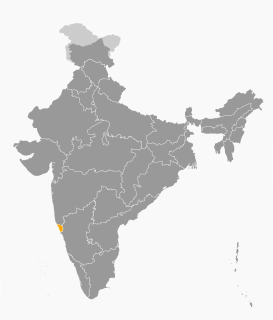
The following outline is provided as an overview of and topical guide to Goa:
